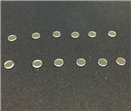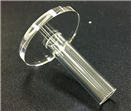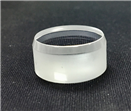

Time:2024-01-30
The process of double-sided grinding and polishing is to place a star wheel between the upper and lower plates of the double-sided grinding and polishing machine. The star wheel has a hole of appropriate size, and a sapphire lens is placed inside the hole. The rotation of the star wheel drives the sapphire to rotate, thereby achieving uniform grinding and polishing. Due to the rotation of the upper and lower plates, there is a linear velocity difference that decreases from the edge to the center. Assuming the planetary gears do not rotate, due to the existence of this linear velocity difference, there is a difference in thickness from the edge to the center after grinding (thin at the top of the edge and thick in the middle).

If the sapphire lens is a disc, during grinding and polishing, when the high point of the sapphire contacts the surface of the disc, the rotation of the planetary gear will generate a thrust that pushes the high point towards the low point. That is to say, the disc will adapt to the processing position on its own. Rotate to maintain global thickness consistency. However, if it is not perfectly round, the sapphire wafer cannot rotate during the grinding process due to the fixture, and can only be passively ground and polished, resulting in inconsistent thickness. Although this inconsistency is small, it will not be used during polishing. At that time, this difference will be magnified and manifested as being unable to be fully resolved for a long time.
When polishing, it is necessary to carefully analyze the placement method. In order to ensure sufficient contact between the grinding disc and the sapphire lens, the edges are often placed outside the grinding disc, which can ensure that the grinding disc will not deform due to the lack of abrasive on it. But due to the rotation of the planetary gear during operation, the sapphire pieces exposed on the grinding disc are often in the corner area and also the part with fast linear velocity. This will result in the corner area being noticeably thinner than other areas, which is why polishing cannot penetrate all four corners.
For this situation, the solution is flipping, which means dividing a normal grinding cycle into at least two stages. After grinding for half the set time, flip the sapphire lens over, not just up and down. It also needs to be flipped inside and outside to effectively reduce the thickness difference. It would be even better if it could be flipped three to four times, which can basically solve the problem of thickness difference and naturally solve the problem of opaque polished edges and corners.






Tel
Mobile phone
Customer service
TOP